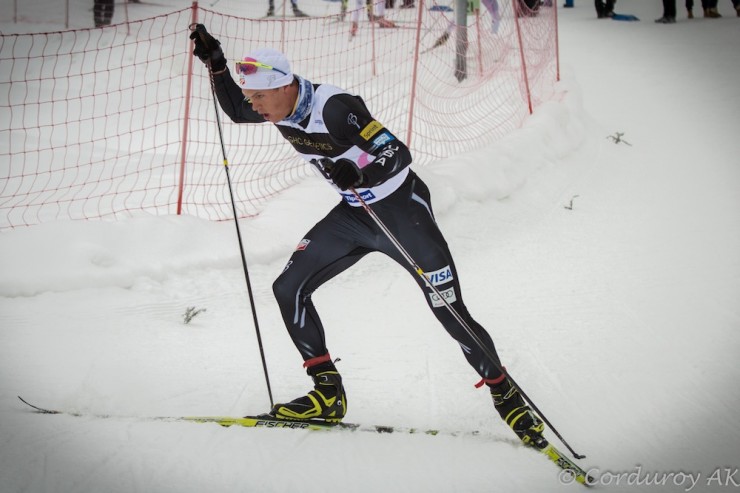
Consistency has been the name of the game for Erik Bjornsen (Alaska Pacific University/U.S. Ski Team) at U23 World Championships this week. He started off in 10th in the classic sprint, took 15th in the 15 k freestyle and on Saturday wrapped things up with a 16th place finish in the 30 k skiathlon.
At the end of three races at the championships, Bjornsen reflected on his performance as a whole. Is he happy with stability in his results? Yes. Satisfied with top-20s? Not even close.

“I’ve got to be happy with the place, but again I think I could have made some changes to get a little bit higher,” Bjornsen said over the phone from Liberec. “But all in all it was a good race.”
A five-lane chevron that narrowed to three lanes, and then again to two in a matter of meters, made for a chaotic start to the 68-man skiathlon. The first few minutes of the race were defining — either get in a good position or get left behind. Bjornsen said he eventually managed to position himself well, but it was hard to ski relaxed in the opening kilometers.
“It was really hard to ski smooth those first three to four laps around,” he said. “I finally got in a good position and it started turning into a real race.”
After the classic leg, Bjornsen came through the pit in sixteenth place, about 40 seconds down to the leaders. He had ambitions to redeem himself of a disappointing skiathlon in Canmore, where he moved too early and “fried myself trying to hang with the leaders.” Saturday was to be about being conservative to avoid the same mistake.
Bjornsen thought the revised strategy worked out OK for him in Liberec. He couldn’t see the Russian breakaway from where he was skiing, but the chase pack through fifteenth place was within striking distance.
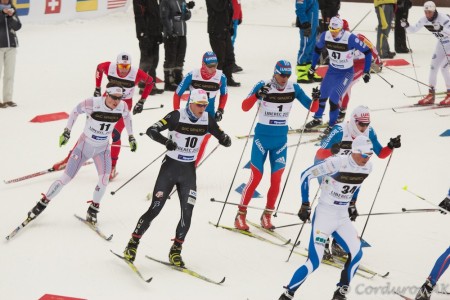
“At times I was ten meters off that and I should have just gone for it and scrambled up to the group, but I haven’t done a lot of 30 ks and I’m still learning what I’m capable of doing,” he said. “I just paid the price of a small move closing a gap, so you have to be really careful when you can make that move. Maybe I should have gone for it, but it was good.”
Though he didn’t bridge the gap to the first chase group, Bjornsen didn’t have to ski completely alone. He traded leads on and off with a French skier, which was better than working solo, but at times slowed him up.
“Whenever he took the lead we got farther away from that pack,” Bjornsen said.
So with two 2.5 k laps to go he decided to make a run for it.
“I could see those guys start to come close to us and I decided to go for it. I skied the last few laps by myself and almost caught them, but didn’t really change positions after that,” Bjornsen said. “I was pretty psyched with how I felt the last 5 k; I was feeling pretty strong… Last year when I’d get to skating I’d feel like people were passing me, but I’m feeling confident in my skating right now.”
Though it wasn’t the top 10 he was hoping for, he was relatively satisfied with 16th.
“I think it’s a pretty good result, and I was two minutes back, which was about the same as I was in the 15 k,” he said. “It’s great to be feeling how I’m racing now… I didn’t really expect this going into the season but I felt like I trained hard over the summer and it’s definitely paid off this year.”
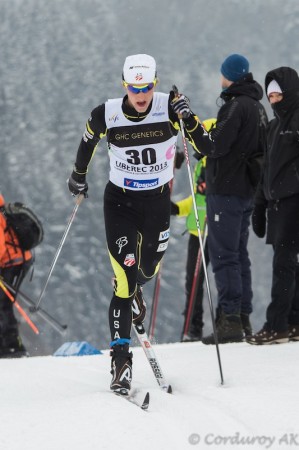
A few minutes behind Bjornsen, Eric Packer (SMS T2) saw his season start to head towards an upswing. The Alaska native has felt off so far in his rookie season as a professional, but in the skiathlon on Saturday felt things started to come around.
Packer finished 40th overall, 4:47 behind Sergey Ustiugov’s (RUS) winning time. The bottleneck at the beginning of the mass start set him back, but he skied the 32nd-fastest skate leg in the second half of the race.
“The race went out pretty easily up front, but the pack was churning as people fought for position,” Packer said. “There were some bad bottlenecks on the climbs and we came to a complete stop in several places. I should have been more aggressive early on and gotten up front, since the stop-and-sprint yoyo effect was much more taxing than the consistent pace the leaders were setting.”
Packer lost the pack on the fourth lap and came through the exchange in 60th place, 2:16 down from the leaders. He picked people off in the skate portion, however, and felt the best he has all season.
“After the transition to skating I started feeling much better and was able to start picking people off,” he said. “The last lap, I put the hammer down and passed a group of racers, which always feels good… I am happy with how I felt, especially in the skate leg. It was the first time since last season that I felt good while racing.”
Packer couldn’t help wondering what might have been if he’d been aggressive in the early kilometers but was ultimately pleased to be feeling better.
“The result was OK, but I’m hungry for better,” he concluded. “But at least my skiing seems to finally be on the right track.”
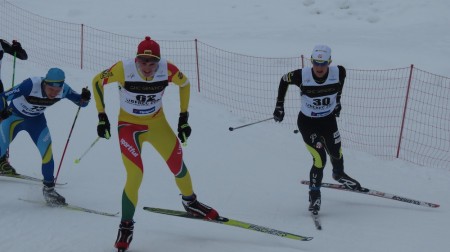
Bjornsen and Packer were the only two American men to compete in the skiathlon on Saturday. The other half of the men’s squad came down with the flu, food poisoning, or some combination therein and did not start. Sam Tarling (Dartmouth College) went on an IV on Friday night and was still feeling too ill to race Saturday morning.
“I got some really bad food poisoning and was up all night vomiting,” Tarling wrote in an email. “I went on IV yesterday, which helped me get some hydration back, but I’m still nauseous and weak. It’s too bad because I had really high hopes for the skiathlon.”
David Norris (Montana State University) also felt ill on Saturday, though he characterized it as “just fever and sinus infection-type symptoms.”
According to U.S. Ski Team development coach Bryan Fish, athletes from several nations have stuggled with illness this week. Each team is staying in the same hotel in Liberec, and Fish said skiers from Canada, Slovenia and Finland have also gotten ill over the course of the championships.
“I really [feel] for these two guys,” Fish said. “It’s very challenging to train for these competitions, make sacrifices to be here, and get hammered with the flu.”
Packer said his efforts in the skiathlon were motivated in part by his teammates. “I wanted to have a good one for those guys if I could. They’re some of my best friends, and I know they would have loved the opportunity to race today.”
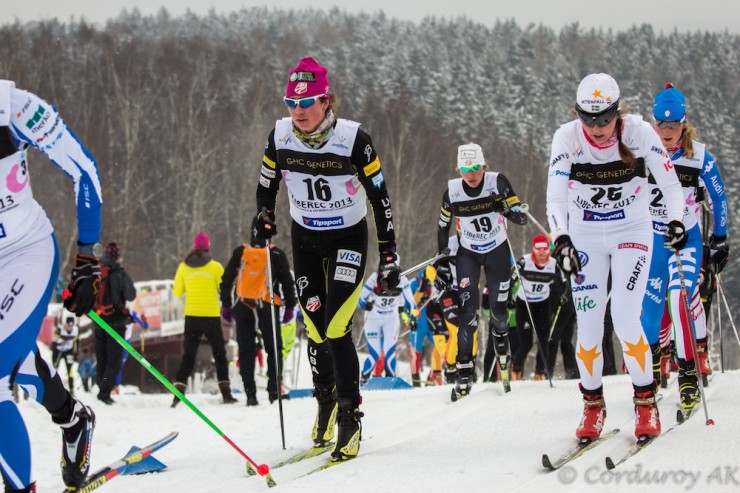
The American women were led once again by Caitlin Patterson (Craftsbury Green Racing Project) in the 15 k skiathlon, who took 19th overall for her second top-20 of the week. In a mass start that was just as chaotic as the men’s, Patterson felt she skied well for the first few kilometers, just off the lead group. At 25-30 skiers strong she said it was a tricky group to ski in, particularly on changeable terrain.
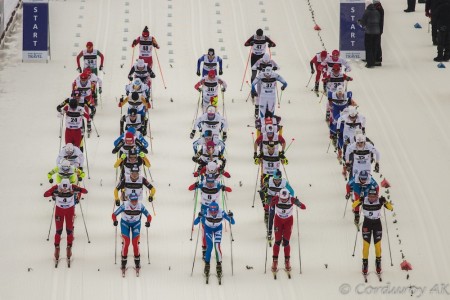
“At the top of the first big hill there is a very steep pitch — steep enough that when you’re frantic and fighting for positions it isn’t very easy to stride (at least for us girls),” Patterson said. “Many people jumped out of the tracks, or on top of the tracks, to herringbone run, which is very awkward in a pack of 50 to say the least.”
Though she has generally enjoyed racing the courses in Liberec, Patterson added that the classic course was perhaps ill-suited for a mass start.
In such conditions, she got off to a start just outside the top-20 at the end of 7.5 k, about 27 seconds down to the leaders. Patterson could see the entire field stretched in front of her on one early climb in the skate leg, thought for a moment they were close enough to catch, but didn’t quite pass as many people as she wanted.
She skied the rest of her race with a small group that included two Estonians and a Swede.
“It was nice to be able to work with people a little bit, but it seemed like they faded and surged in strange places compared to how I was skiing,” Patterson said.
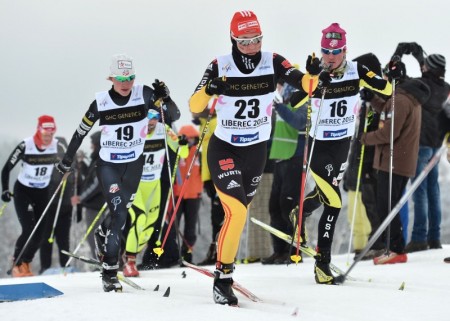
She got into a three-way sprint for the line with the Estonians at the finish, where one of them got through just ahead of her. Patterson finished 19th in 42:02.7, 1:45 back from Ragnhild Haga’s (NOR) winning mark.
With a 38th in the sprint, a 14th in the 10 k and a 19th-place on Saturday now under her belt, Patterson gave her week in Liberec a good rating.
“I’m happy with my races here at U23s, but not ecstatic,” she said. “I definitely gave the races my best each day, and they did go pretty well, but I think I can do better in future races. The experience I’ve gained has been extremely valuable though, and I’ll remember these races for a long time — how close I’ve been to the top European U23s, and yet how I need to work on skiing a little faster each kilometer to get to the very top of the field.”
Sophie Caldwell (SMS T2) was the second American to come through the finish in 28th, 3:15 off the winning time. She began the classic half of the skiathlon skiing right behind Patterson but fell when a Russian skier decided to “ski directly through everyone” and went down right in front of Caldwell. From that point on she was never able to find that extra gear.
“After that I could never really reconnect with the pack and got pretty tired out,” she said.
Caldwell came through the exchange in 29th, where she thought she could begin to race her way back up through the pack. But it was not to be.
“I was so ready to get to skate skiing that I face planted again when I started trying to skate on my classic skis in the exchange zone!,” Caldwell said. “I felt fine for my skate leg but it was hard to get back in it and I didn’t feel like I had that extra gear. I’m a little bummed because I was really looking forward to this race but it happens and everyone has bad days!”
On the whole, however, Caldwell is pleased with her results from U23s, particularly with a 9th place in the classic sprint.
“I was really happy with the sprint and how I skied in the 10k skate so that was encouraging,” she said.
After leaving Liberec, both Patterson and Caldwell travel to Latvia and Estonia at the beginning of February to compete in a series of FIS races.
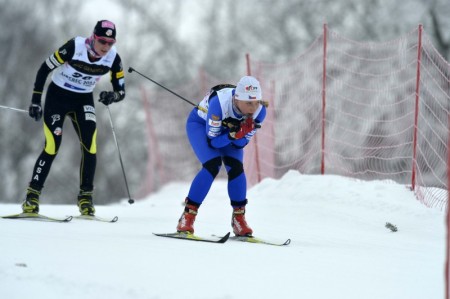
Annie Pokorny (Middlebury College) finished less that two seconds behind Caldwell in 29th to put three Americans in the top 30. Pokorny had the 33rd-fastest classic split and the 21st-ranked skate split.
“My race improved with each second, even though the beginning wasn’t all that impressive,” Pokorny said. “I was certainly taken aback by the pace and aggression in the start, and it took until my skate leg to calm down and ski my own race. Once I had my feet back under me, I was able to work my way back up.”
Pokorny gauged her week at U23s as pretty successful.
“At the very least, I was consistent!” she said. “Just being in the same race as the fastest girls in the world is so cool. I still cannot get the image of Haga taking the hill during the skate race out of my mind. It’s unbelievable skiing, and it’s attainable.”
Annie Hart (Dartmouth College) finished 20 seconds behind Pokorny in 31st, just nine seconds out of the top 30. Like her teammates, Hart felt the effects of a “crazy” mass start.
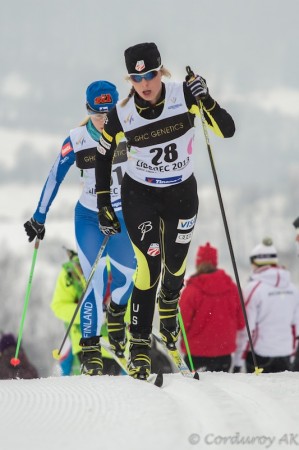
“It was the first time (and I hope the last) I ever get elbowed in the face, some of those girls were very aggressive,” she said. “But I just hopped out of the tracks and that ended up working pretty well!”
Hart finished 3:37 behind Haga’s winning time and thought her race, on the whole, went well.
“I outsprinted some girls at the end which always makes for a more a exciting and happier day,” she said.
Pokorny and Hart both join to the NCAA carnival circuit upon returning to the U.S. after the championships.
Women’s 15 k skiathlon results.
Thanks to Logan Hanneman and Gus Kaeding for their photos.
Audrey Mangan
Audrey Mangan (@audreymangan) is an Associate Editor at FasterSkier and lives in Colorado. She learned to love skiing at home in Western New York.



